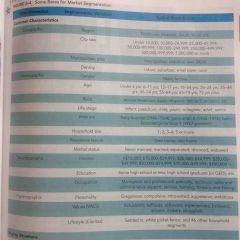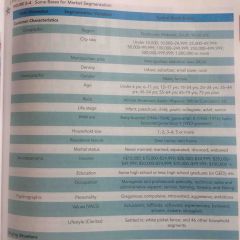![]()
![]()
![]()
Use LEFT and RIGHT arrow keys to navigate between flashcards;
Use UP and DOWN arrow keys to flip the card;
H to show hint;
A reads text to speech;
25 Cards in this Set
- Front
- Back
- 3rd side (hint)
|
Strategic Marketing Plan |
Guide the allocation of an organization's resources - Evolves from an organization's overall corporate strategy and serves as a guide for specific marketing programs and policies |
|
|
|
Market segments |
Target markets he company wishes to pursue |
|
|
|
Market opportunities |
Areas where there are favorable demand trends, where the company believes customer needs and opportunities are not satisfied and where it can compete effectively. |
|
|
|
Competitive analysis |
"What can the competition do to you?" * sobe: Arizona tea kept buying the trucks sobe used for shipping |
|
|
|
Competitive advantage |
Something special a firm does or has that gives it an edge over competitors |
|
|
|
Target Marketing |
Developing different marketing strategies to satisfy different consumer needs, Involves (4) basic steps: 1) identifying markets with unfulfilled needs 2) determining market segmentation 3) selecting a market to target 4) positioning through market strategies |
|
|
|
Identifying markets |
Step (1) of target marketing: Identifies specific needs of groups of people and selects one or more of these segments as a target and develops marketing programs directed to each |
|
|
|
Market segmentation |
Step (2) of target marketing: Dividing a market into distinct groups that have common needs and will respond similarly to a marketing action. |
"Act of..." |
|
|
Selecting a target market |
Step (3) in target marketing: Determining how many segments to enter and determining which segments offer the most potential. |
|
|
|
Market positioning |
Step (4) of target marketing: "What do we want that target market segment to think of us?" - a brand's product image in the market place relative to competing products or brands |
|
|
|
Bases for segmentation (5 segmentation strategies) |

(5) methods available for segmenting markets: 1) geographic 2) demographic 3) psychographic 4) behavioristic 5) benefit |
|
|
|
Demographic segmentation |

Dividing the market based on gender, age, race, life stage, birth era, household size, residence tenure (renter or owner), marital status |
|
|
|
Geographic segmentation |

Dividing markets based on geographic units |
|
|
|
Psychographic segmentation |

Dividing the market on the basis of personality, values, and/or lifestyles |
|
|
|
Behavioristic segmentation |
Dividing consumers into groups according to their usage, loyalties, or buying responses to a product * 80-20 rule: 20% of customers account for 80% of sales volume |
|
|
|
Benefit segmentation |

The grouping of consumers on the basis of attributes sought in a product Example: water with vitamins, water with flavor, etc. |
|
|
|
Undifferentiated marketing (1 of 3) |
Involves ignoring segment differences and offering just one product or service to the entire market |
|
|
|
Differentiated marketing |
Involves marketing to a number of segments, developing separate marketing strategies for each. Example: Marriott hotel offers different packages for business, vacation, short-term and long-term customers |
|
|
|
Concentrated marketing |
When the firm selects one segment and attempts to capture a large share of this market. Example: Ferrari and Rolls-Royce |
|
|
|
Brand identity |
Combination of name, logo, symbols, design, packaging, and image associations held by consumers |
|
|
|
Brand equity |
Intangible asset of added value or goodwill that results from the favorable image, impressions of differentiation, and/or strength of consumer attachment to a company name, brand name, or trademark |
|
|
|
Promotional push strategy |
Goal is to push the product through the channels of distribution by aggressively selling and promoting the item to the resellers or trade |
|
|
|
Promotional push strategy |
Goal is to push the product through the channels of distribution by aggressively selling and promoting the item to the resellers or trade |
|
|
|
Trade advertising |
Interest wholesalers and retailers and motivate them to purchase its products for resale to their customers * advertising usually appears in publications that serve a particular industry |
|
|
|
Promotional pull strategy |
Spending money on advertising and sales promotion efforts directed toward the ultimate consumer. Goal: to create demand among consumers and encourage them to request product from retailer |
|

